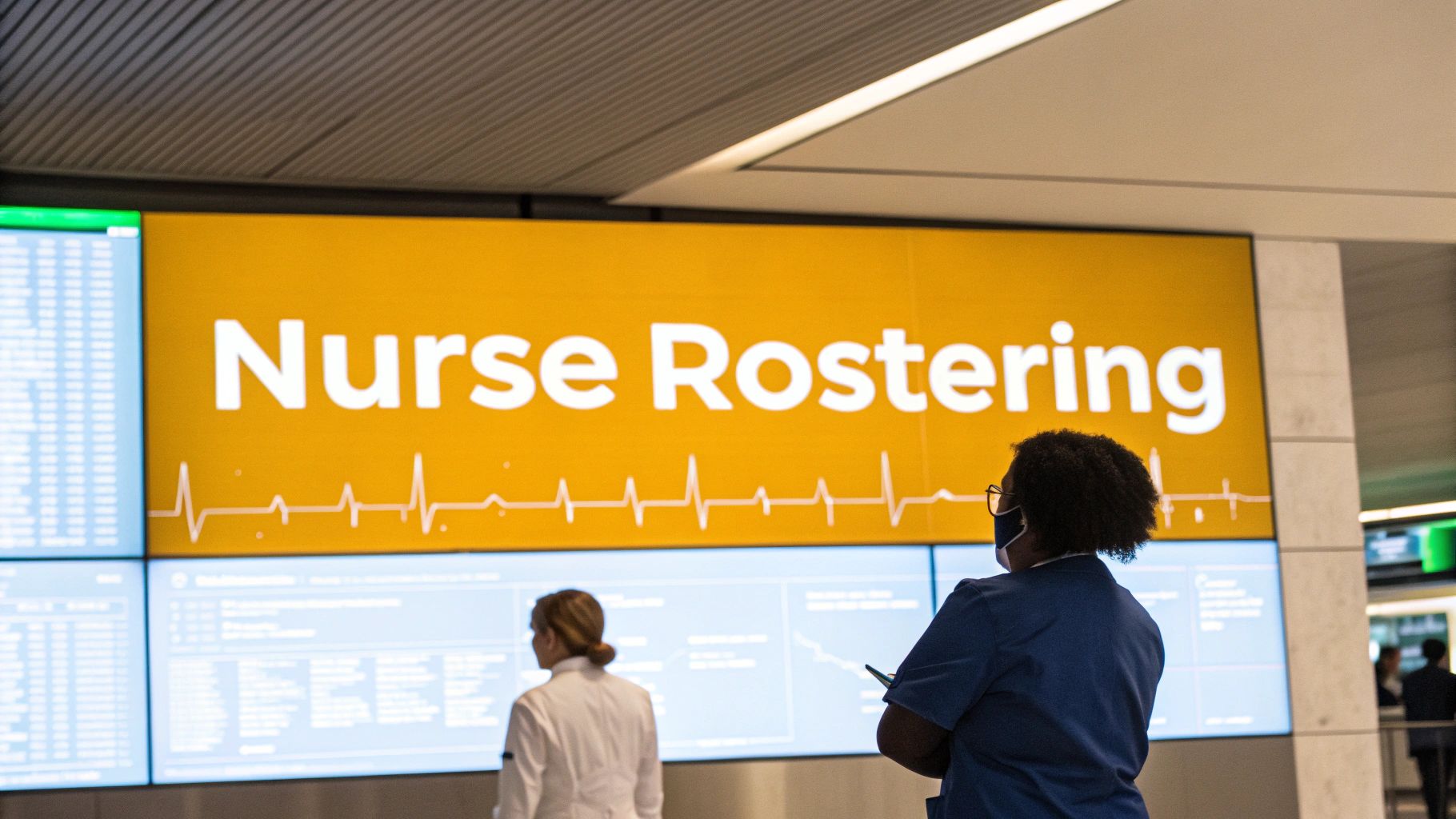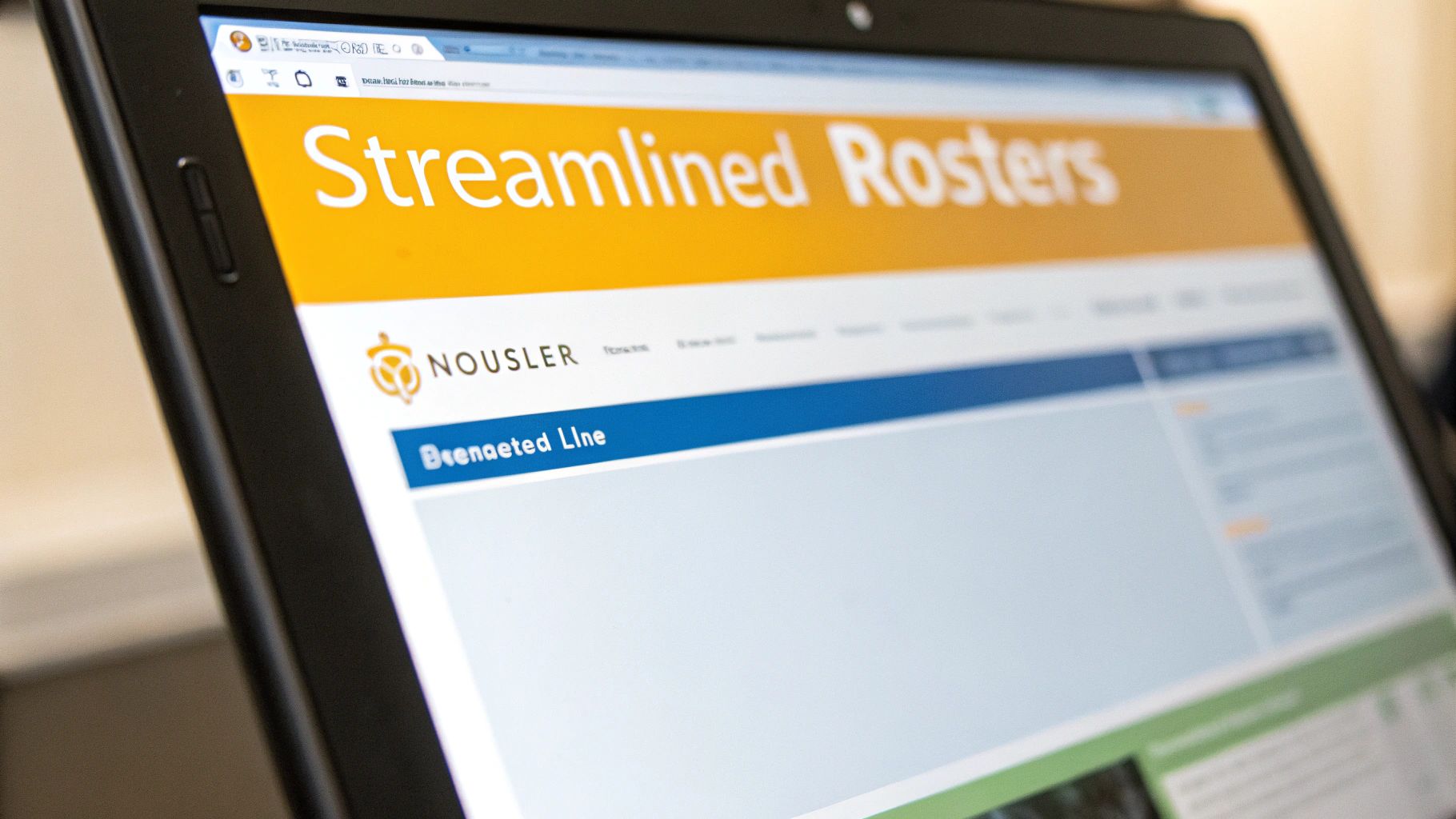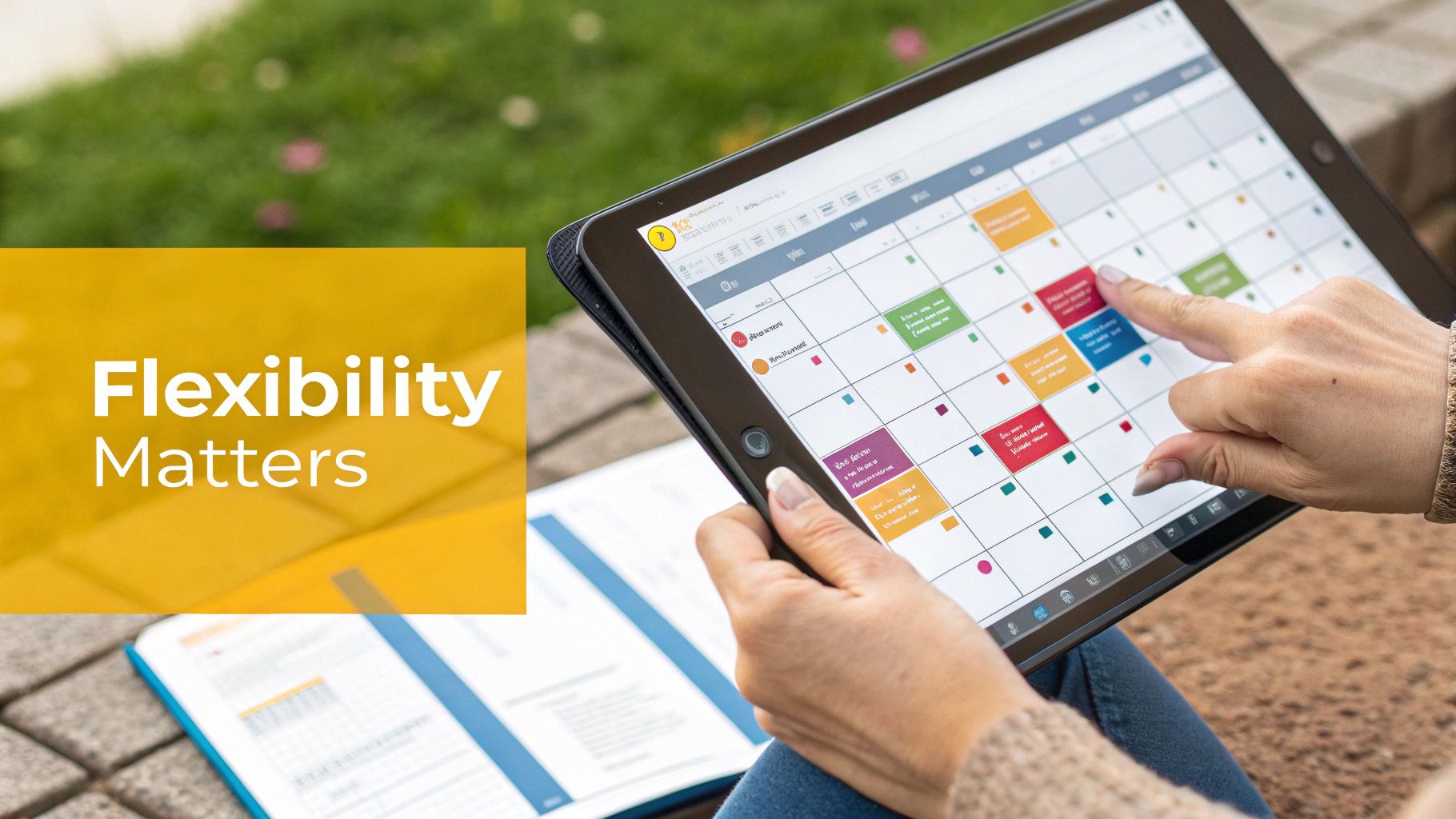From our resource library for organizational scheduling and management.
Nurse Rostering Software: The Ultimate Guide to Transform Healthcare Scheduling

Understanding the Evolution of Healthcare Scheduling

The way hospitals and medical facilities handle staff scheduling has changed dramatically over the past few decades. In the early days, healthcare facilities relied on basic tools like bulletin boards and paper calendars to manage staff schedules. While these simple methods worked for smaller operations, they quickly became overwhelming as medical centers grew. Staff coordinators spent countless hours juggling shift changes, time-off requests, and coverage needs - often leading to scheduling conflicts and staffing gaps.
From Manual to Digital: A Necessary Shift
As healthcare facilities expanded and became more complex, the limitations of manual scheduling became clear. Managing schedules for large teams with different skills, certifications, and shift patterns was nearly impossible with paper-based systems. Early scheduling software offered some improvements but couldn't fully handle the unique demands of healthcare staffing. While these basic digital tools were a step forward, healthcare administrators needed more capable solutions to effectively manage their growing workforce.
The Rise of Nurse Rostering Software
The need for better scheduling tools led to the development of specialized nurse rostering software. These systems do much more than just assign shifts - they track real-time staff availability, facilitate team communication, and match staff skills with specific roles. The software uses smart algorithms to create schedules that work for both the facility and its staff, taking into account factors like required certifications, staff preferences, and labor regulations. This focus on effective nurse scheduling isn't new - researchers have studied the nurse scheduling problem (NSP) since its formal introduction in 1976. The challenge of creating optimal schedules while meeting various requirements shows why advanced software is so important. For more details about this topic, check out the research on Nurse Scheduling Problems.
Modern Solutions for Modern Challenges
Today's scheduling software offers healthcare facilities a complete set of workforce management tools. Beyond basic scheduling, these systems help with predicting staffing needs, managing budgets, and tracking key performance metrics. This helps medical centers maintain proper staffing levels, control overtime costs, and keep their teams happy. The improvement in healthcare scheduling continues as facilities look for better ways to deliver quality patient care while supporting their staff's work-life balance.
Improving Healthcare Through Better Scheduling Systems

Healthcare facilities are discovering that better scheduling does more than just arrange work shifts. Nurse rostering software helps solve real problems that hospitals face daily - from keeping staff happy to providing better patient care. The old way of creating schedules by hand often leads to uneven workloads and last-minute changes that frustrate everyone involved.
Why Traditional Scheduling Falls Short
Hospitals today deal with unique challenges that make manual scheduling increasingly difficult. Staff shortages, changing patient needs, and the demand for flexible work arrangements create scheduling headaches that paper-based systems can't solve. Forward-thinking hospitals are turning to data-driven scheduling tools to address these issues. These systems help create fair schedules that consider both staff preferences and patient needs, which leads to happier employees and better care.
Real Benefits of Smart Scheduling
When hospitals use scheduling software, they can adjust staffing in real-time and plan ahead more effectively. The results speak for themselves - patients receive better care because the right staff are available at the right times. Nurses and other healthcare workers stay in their jobs longer because they have more control over their schedules and a better work-life balance. These improvements also help the bottom line by reducing overtime and making better use of available staff. The numbers show this approach is catching on - the nurse scheduling software market is set to reach USD 0.81 billion by 2032, growing at 10.8% yearly. This growth shows that good scheduling is essential for modern healthcare. Learn more about market trends here. For practical scheduling tips, check out: How to master nurse rostering.
Creating Better Healthcare Workplaces
Using smart scheduling tools helps build stronger healthcare organizations that last. When staff scheduling works well, everything improves - from patient care to employee satisfaction to daily operations. As healthcare continues to change and grow, good scheduling will become even more important for supporting medical professionals in their vital work.
Building Resilient Scheduling Systems for Healthcare Crises
Healthcare facilities face constant change and unpredictability. Patient volumes shift daily, staff schedules change frequently, and unexpected events can quickly derail carefully planned staffing arrangements. These ongoing challenges highlight why healthcare organizations need flexible scheduling systems that can handle sudden changes. Modern nurse scheduling software has become essential for managing these daily complexities while maintaining stable operations.
Crisis Management and Staffing Stability
When crises hit - whether it's a natural disaster, disease outbreak, or sudden surge in patients - healthcare facilities need to respond quickly. Standard paper schedules and basic spreadsheets often can't keep up with rapid staffing changes. Advanced scheduling software allows hospitals to instantly find staff with needed skills, adjust shift assignments on the fly, and keep all team members updated in real-time. This helps ensure patients receive continuous care while preventing staff burnout.
Adaptability and Real-Time Adjustments
The COVID-19 pandemic showed just how vital flexible scheduling tools are for healthcare organizations. Hospitals faced unprecedented challenges with skyrocketing patient numbers and staff shortages from illness and quarantines. Digital scheduling systems became crucial for managing constantly changing staff levels and ensuring adequate coverage, especially in critical care units. Learn more about how the pandemic impacted scheduling needs here. The crisis underscored the importance of features like remote access, instant updates, and data-driven planning.
Predictive Analytics and Proactive Scheduling
Forward-thinking healthcare facilities now use scheduling software to get ahead of potential staffing issues before they occur. Smart algorithms analyze past data on patient volumes, seasonal trends, and other factors to forecast future staffing needs. This helps hospitals prevent coverage gaps by adjusting schedules early, controlling overtime costs, and placing the right staff where they'll be needed most.
Maintaining Optimal Care Delivery
At its core, effective scheduling exists to support quality patient care. By implementing robust scheduling systems, healthcare organizations can handle even the most challenging situations while maintaining high care standards. Modern scheduling tools help balance patient needs with staff wellbeing, creating more stable healthcare environments. The ability to quickly adjust schedules, predict upcoming demands, and make data-driven staffing decisions lets healthcare professionals focus on their most important work - caring for patients.
Essential Features and Implementation Success Strategies

Getting nurse scheduling right starts with choosing and setting up the right software. While buying software licenses is straightforward, getting staff to actually use it takes careful planning. Let's look at what features you need and how to get your team on board.
Must-Have Features in Nurse Rostering Software
Good scheduling software makes life easier for everyone - nurses get fair schedules, managers save time, and patients get better care. Here are the key features that matter most:
Automated Scheduling: Smart scheduling tools do the heavy lifting by matching nurses' skills and availability to shift requirements. This frees up schedulers to focus on handling special cases and making sure staffing levels work.
Real-Time Availability: Managers can quickly see who's free to work, making it much faster to fill sudden openings. When someone calls in sick, finding coverage becomes much simpler.
Mobile Access: Nurses can check schedules, request time off, and swap shifts right from their phones. This simple change makes a big difference in keeping everyone connected and the schedule running smoothly.
Compliance Tools: The software keeps track of work hour rules, union agreements, and hospital policies automatically. This protects both nurses and the hospital from scheduling mistakes that could cause problems.
Data Insights: Clear reports show important patterns in staffing costs, overtime, and how efficiently nurses are scheduled. These numbers help managers make better scheduling decisions over time.
Implementing Nurse Rostering Software Successfully
Getting new scheduling software to work well takes more than just installing it. You need buy-in from staff, good training, and ongoing improvements based on feedback.
Change Management: Take time to show staff how the new system will make their lives better. Getting nurses involved early helps smooth the transition and catch potential issues.
Thorough Training: Make sure everyone knows how to use the key features they need. Keep offering help and tips as people get used to the new way of doing things.
Regular Updates: Check in often to see what's working and what needs adjusting. Small tweaks based on real use make the system more helpful over time.
Team Input: Work closely with nurses, schedulers and IT throughout setup and beyond. When everyone has a voice, the final system fits better with how people actually work.
For instance, nurses might spot ways to make shift swapping easier, while IT can help connect the scheduling system to other hospital software smoothly. These practical insights often lead to the biggest improvements.
You might be interested in: How to master nurse rostering and other useful resources. The right nurse rostering software, set up thoughtfully with input from those who'll use it daily, can make scheduling much smoother for everyone involved. Focus on getting the essential features in place and helping your team embrace the change. This creates better schedules, happier staff, and ultimately better patient care.
Maximizing Return on Investment Through Strategic Optimization
A well-implemented nurse rostering system can transform how healthcare facilities manage their workforce. But having the software alone isn't enough - you need a clear plan to get the most value from your investment. Let's explore practical ways to optimize your scheduling system to improve operations, boost staff morale, and deliver better patient care.
Measuring the Impact of Nurse Rostering Software
The first step is tracking concrete improvements that show how the software affects your facility. Beyond basic scheduling automation, focus on these key metrics:
- Cost Savings: Compare overtime expenses before and after implementation. Many hospitals report 20-30% reductions in overtime costs through better schedule planning and staff allocation.
- Employee Retention: Survey your nurses regularly about job satisfaction. When staff can easily swap shifts and have more control over their schedules, they tend to stay longer and feel more engaged.
- Agency Staff Usage: Keep tabs on how often you need temporary nurses. Good forecasting tools help match staffing to patient needs, reducing reliance on costly agency workers.
- Care Quality: Watch patient satisfaction scores and care metrics. When nurses work reasonable hours with proper rest, patients get better care.
Strategies for Continuous Improvement
Getting the most from your scheduling system requires ongoing fine-tuning. Here's how to keep improving:
- Analyze the Data: Check your scheduling reports monthly to spot patterns. You might find certain shifts need adjusting or some units are consistently understaffed at peak times.
- Ask Your Staff: Make it easy for nurses to share feedback about the scheduling process. Their daily experiences often reveal practical ways to make the system work better.
- Use Advanced Tools: Take advantage of features like demand forecasting and compliance tracking. These tools help you plan ahead while following all workplace rules.
- Connect Your Systems: Link your scheduling software to your payroll and time-tracking systems to cut down on paperwork and reduce errors.
Achieving Sustainable Results
For lasting success, make schedule optimization part of your facility's regular operations. Set up quarterly reviews to check how well the system is working and where it needs adjustment. Train new staff thoroughly on the software and offer refresher sessions for everyone else.
Remember that good scheduling directly affects patient care - when nurses have predictable, fair schedules, they provide better care. Keep gathering feedback, analyzing results, and making improvements. This ongoing attention will help your nurse rostering software deliver real value, both for your budget and your patients' wellbeing.
The Future of Healthcare Scheduling Technology

Managing healthcare staff schedules has come a long way from basic digital calendars. As hospitals and medical facilities face growing scheduling challenges, new technologies are emerging to help them work smarter. Let's explore how nurse scheduling tools are evolving to meet tomorrow's needs.
AI and Machine Learning: Predictive and Personalized Scheduling
Smart scheduling powered by artificial intelligence is changing how healthcare facilities plan their staffing. By analyzing data from past schedules, patient numbers, and local events, these systems can spot patterns and suggest optimal staffing levels. For instance, the software might notice that your emergency department needs more nurses during flu season or after major sporting events. It can also match nurses to shifts based on their specific skills and preferences, helping prevent burnout while maintaining proper coverage.
Integrating with Other Healthcare Systems
Modern scheduling needs to work smoothly with other hospital systems. When scheduling software connects directly to patient records and admission systems, it can adjust staffing levels automatically as needs change. This means managers spend less time manually updating schedules and more time focusing on patient care. Better connected systems also help different departments coordinate more effectively, ensuring the right staff are available at the right time.
Mobile-First and Cloud-Based Solutions
Nurses today expect to manage their schedules from their phones. Cloud-based scheduling lets staff check their upcoming shifts, request time off, and swap shifts with coworkers - all from any device. This flexibility makes life easier for both nurses and schedulers. The focus on mobile-friendly design means nurses can quickly update their availability or pick up extra shifts, even during busy days.
Focus on Staff Well-being and Retention
With the ongoing nurse shortage, keeping experienced staff happy and healthy is crucial. Modern scheduling tools help by monitoring work patterns to prevent overload and suggest breaks when needed. They also give nurses more control through features like self-scheduling and shift bidding. Learn more in our article about How to master nurse rostering with Acroroster. These improvements help hospitals keep their valuable nursing staff while reducing costly turnover.
Preparing for the Future of Scheduling
Hospitals can take practical steps now to get ready for these advances in scheduling technology. Start by training staff on new digital tools and identifying which scheduling tasks take the most time. Look for areas where automation could help reduce errors and save time. Taking these steps today will help your facility make the most of tomorrow's scheduling innovations.
Ready to experience the future of nurse rostering? Discover Acroroster today and transform your scheduling process.
Article created using Outrank